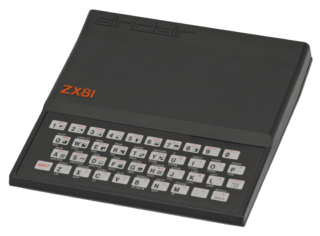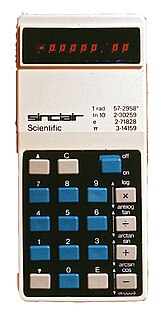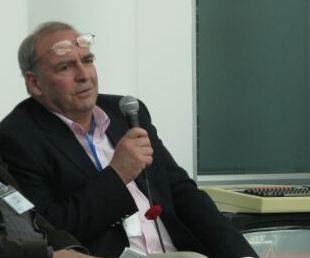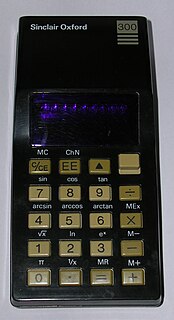
An electronic calculator is typically a portable electronic device used to perform calculations, ranging from basic arithmetic to complex mathematics.

The ZX81 is a home computer that was produced by Sinclair Research and manufactured in Dundee, Scotland, by Timex Corporation. It was launched in the United Kingdom in March 1981 as the successor to Sinclair's ZX80 and designed to be a low-cost introduction to home computing for the general public. It was hugely successful; more than 1.5 million units were sold. In the United States it was initially sold as the ZX-81 under license by Timex. Timex later produced its own versions of the ZX81: the Timex Sinclair 1000 and Timex Sinclair 1500. Unauthorized ZX81 clones were produced in several countries.

Sir Clive Marles Sinclair is an English entrepreneur and inventor, most commonly known for his work in consumer electronics in the late 1970s and early 1980s.

The Sinclair Scientific calculator was a 12-function, pocket-sized scientific calculator introduced in 1974, dramatically undercutting in price other calculators available at the time. The Sinclair Scientific Programmable, released a year later, was advertised as the first budget programmable calculator.

Masatoshi Shima is a Japanese electronics engineer. He was one of the architects of the world's first microprocessor, the Intel 4004. In 1968, Shima worked for Busicom in Japan, and did the logic design for a specialized CPU to be translated into three-chip custom chips. In 1969, he worked with Intel's Ted Hoff and Stanley Mazor to reduce the three-chip Busicom proposal into a one-chip architecture. In 1970, that architecture was transformed into a silicon chip, the Intel 4004, by Federico Faggin, with Shima's assistance in logic design.
Sinclair Radionics Ltd was a company founded by Sir Clive Sinclair in Cambridge, England which developed hi-fi products, radios, calculators and scientific instruments.

Christopher Curry is the co-founder of Acorn Computers, with Hermann Hauser and Andy Hopper. He became a millionaire as a result of Acorn’s success.
Sinclair Research Ltd is a British consumer electronics company founded by Clive Sinclair in Cambridge. It was originally incorporated in 1973 as Westminster Mail Order Ltd, renamed Sinclair Instrument Ltd, then Science of Cambridge Ltd, then Sinclair Computers Ltd, and finally Sinclair Research Ltd. It remained dormant until 1976, when it was activated with the intention of continuing Sinclair's commercial work from his earlier company Sinclair Radionics, and adopted the name Sinclair Research in 1981.
Nigel Searle is the former managing director of Sinclair Research Ltd, and one of the company's longest-serving employees. He joined Sinclair Radionics in 1973, and for most of the 1970s, Searle worked for Sinclair in the United States to promote the company's calculators and other products. In 1977, with Sinclair in financial trouble, Searle left the company. He rejoined in 1979 when Sir Clive Sinclair formed Science of Cambridge and continued to work from the US, successfully promoting the ZX80 and ZX81 personal computers. In spring 1982, he moved back to the United Kingdom as Sinclair's managing director, a post he retained until 1986 when Amstrad took over the company's computer business.
The Sinclair Sovereign was a high-end calculator introduced by Clive Sinclair's company Sinclair Radionics in 1976. It was an attempt to escape from the unprofitable low end of the market, and one of the last calculators Sinclair produced. Made with a case of pressed steel that a variety of finishes, it cost between GB£30 and GB£60 at a time when other calculators could be purchased for under GB£5. A number of factors meant that the Sovereign was not a commercial success, including the cost, high import levies on components, competition from cheaper calculators manufactured abroad, and the development of more power-efficient designs using liquid-crystal displays. Though it came with a five-year guarantee, issues such as short battery life limited its usefulness. The company moved on to producing computers soon afterwards.

Sinclair Oxford was a range of low-cost scientific calculators manufactured and sold by Sinclair Radionics in England from 1975 until 1976.

The Sinclair Cambridge was a pocket-sized calculator introduced in August 1973 by Sinclair Radionics. It was available both as kit form kit to be assembled by the purchaser, or assembled prior to purchase. The range ultimately comprised seven models, the original "four-function" Cambridge, which carried out the four basic mathematical functions of addition, subtraction, multiplication, and division, being followed by the Cambridge Scientific, Cambridge Memory, two versions of Cambridge Memory %, Cambridge Scientific Programmable and Cambridge Universal.

The MTV-1 Micro TV was the second model of a near pocket-sized television. The first was the Panasonic IC model TR-001 introduced in 1970. The MTV-1 was developed by Clive Sinclair. It was shown to the public at trade shows in London and Chicago in January, 1977, and released for sale in 1978. Development spanned 10 years and included a cash infusion of GB£1.6 million from the UK government in 1976.

The Sharp EL-8, also known as the ELSI-8, was one of the earliest mass-produced hand-held electronic calculators and the first hand-held calculator to be made by Sharp. Introduced around the start of 1971, it was based on Sharp's preceding QT-8D and QT-8B compact desktop calculators and used the same logic circuits, but it was redesigned to fit in a much smaller case.
A transistor is a semiconductor device with at least three terminals for connection to an electric circuit. In the common case, the third terminal controls the flow of current between the other two terminals. This can be used for amplification, as in the case of a radio receiver, or for rapid switching, as in the case of digital circuits. The transistor replaced the vacuum-tube triode, also called a (thermionic) valve, which was much larger in size and used significantly more power to operate.The first transistor was successfully demonstrated on December 23, 1947 at Bell Laboratories in Murray Hill, New Jersey. Bell Labs is the research arm of American Telephone and Telegraph (AT&T). The three individuals credited with the invention of the transistor were William Shockley, John Bardeen and Walter Brattain. The introduction of the transistor is often considered one of the most important inventions in history.

The Sinclair President is a calculator released by Sinclair Radionics in early 1978. There were two models, the President and the President Scientific. They were among the last calculators produced by Sinclair, and their large size was in contrast to the smaller, earlier models, like the Sinclair Executive, which made the company famous. The President models were related to the Sporting Life SETTLER, a calculator designed specifically for betting shops.

Random-access memory is a form of computer memory that can be read and changed in any order, typically used to store working data and machine code. A random-access memory device allows data items to be read or written in almost the same amount of time irrespective of the physical location of data inside the memory. In contrast, with other direct-access data storage media such as hard disks, CD-RWs, DVD-RWs and the older magnetic tapes and drum memory, the time required to read and write data items varies significantly depending on their physical locations on the recording medium, due to mechanical limitations such as media rotation speeds and arm movement.

The Sharp QT-8D Micro Compet, a small electronic desktop calculator, was the first mass-produced calculator to have its logic circuitry entirely implemented with LSI integrated circuits (ICs) based on MOS (metal-oxide-semiconductor) technology. When it was introduced in late 1969, it was one of the smallest electronic calculators ever produced commercially. Previous electronic calculators had been about the size of a typewriter and had logic circuits built from numerous discrete transistors and diodes or small- to medium-scale ICs. The QT-8D's logic circuits were packed into just four LSI ICs.
The Sharp QT-8B Micro Compet, a portable electronic desktop calculator, was the first mass-produced calculator to be battery-powered. Introduced in mid-1970, it was based on its immediate predecessor, the QT-8D introduced in late 1969, but it replaced the QT-8D's integrated power supply with a rechargeable battery pack. It has the same calculating integrated circuits as the QT-8D and is of similar appearance and dimensions; the power supply is the only major difference.

The metal–oxide–semiconductor field-effect transistor (MOSFET, MOS-FET, or MOS FET), also known as the metal–oxide–silicon transistor (MOS transistor, or MOS), is a type of insulated-gate field-effect transistor (IGFET) that is fabricated by the controlled oxidation of a semiconductor, typically silicon. The voltage of the covered gate determines the electrical conductivity of the device; this ability to change conductivity with the amount of applied voltage can be used for amplifying or switching electronic signals. The MOSFET was invented by Egyptian engineer Mohamed M. Atalla and Korean engineer Dawon Kahng at Bell Labs in 1959. It is the basic building block of modern electronics, and the most frequently manufactured device in history, with an estimated total of 13 sextillion (1.3 × 1022) MOSFETs manufactured between 1960 and 2018.














